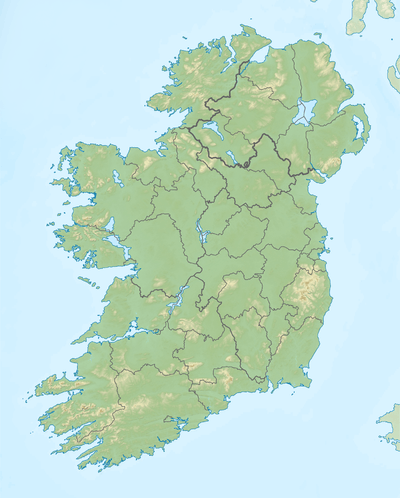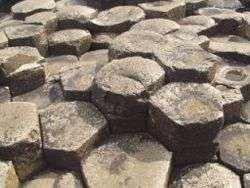Slieve Gullion
| Slieve Gullion | |
|---|---|
| Sliabh gCuillinn | |
 Slieve Gullion from Aughanduff | |
| Highest point | |
| Elevation | 573 m (1,880 ft) |
| Prominence | 478 m (1,568 ft) [1] |
| Listing | Marilyn |
| Coordinates | 54°08′N 6°26′W / 54.133°N 6.433°WCoordinates: 54°08′N 6°26′W / 54.133°N 6.433°W |
| Naming | |
| Translation | mountain of the steep slope (Irish) |
| Geography | |
 Slieve Gullion Location in Ireland | |
| Location | County Armagh, Northern Ireland |
| Parent range | Ring of Gullion |
| OSI/OSNI grid | J024201 |
Slieve Gullion (from Irish: Sliabh gCuillinn, meaning "mountain of the steep slope")[2][3] is a mountain in the south of County Armagh, Northern Ireland. The mountain is the heart of the Ring of Gullion and is the highest point in the county, with an elevation of 573 metres (1,880 ft). At the summit is a small lake and two ancient burial cairns, one of which is the highest surviving passage grave in Ireland. Slieve Gullion plays a prominent role in the mythology and history of the area and dominates the countryside around it, offering views of as far away as Antrim, Dublin Bay and Wicklow on a clear day.[4]
Villages around Slieve Gullion include Drumintee, Mullaghbawn, Lislea, Forkhill and Meigh. The mountain gives its name to the surrounding countryside, and is the name of an electoral area within Newry and Mourne district council. The last local forester, James Toal, a Forkhill native, did more than most to promote the area i.e. South Armagh Festival.
Features
Slieve Gullion is the eroded remains of a Paleocene volcanic complex. It is surrounded by a ring dike known as the Ring of Gullion, a designated Area of Outstanding Natural Beauty (AONB). Slieve Gullion has been shaped by glaciation and exhibits a classic 'crag and tail' glacial feature. The 'tail', made up of glacial deposits, points south, ending at Drumintee. The geological formation was the first ring dike to be mapped,[5] although its significance was not understood until similar structures had been described from Scotland. The rocks of the area are complex and have featured in international geological debate since the 1950s. The site has attracted geologists from all over the world and featured in a number of theories that have been put forward to explain the unusual rock relationships. Some of these theories have now become an accepted part of geological science.[6]
Much of Slieve Gullion is covered with forest, heather, or raw stone, while 612 hectares of dry heath on the mountain has been designated a Special Area of Conservation,[7] an Environmentally Sensitive Area,[8] and an Area of Outstanding Natural Beauty. In July 2006, some areas of gorse were destroyed by a wildfire which may have been started deliberately.[9]
Traces of fields on the mountain's poor soil from farming in earlier times can still be seen. There is also evidence of quarrying. Today Slieve Gullion is used for little economic production but is popular with visitors and trekkers. There is road access to about halfway up the mountain and the remains of an old trail allowing easy access to the summit.
Cairns
There are two cairns on top of the mountain, on either side of a small lake. The southern one is a large passage grave, the highest surviving passage grave in Ireland.[10] In 1961, a team of archaeologists explored the site and set up a 30-person camp 600 feet (180 m) below the summit.[11] The passage grave cairn is 30 m (97 ft) wide and 5 m (16 ft) high. The chamber inside is 3.6 m (12 ft) wide, with a corbelled roof up to 4.3 m (14 ft) from the ground. It contained three large blocks of stone seemingly used as basins. Some bits of worked flint and a barbed-end arrowhead were also found, "the meager remnants that survived the centuries of tomb raiding".[12] The entrance is aligned with the setting sun on the winter solstice.[13] Radiocarbon dating suggests it was built c.3500–2900 BCE.[14] The smaller cairn to the north of the lake was built later, perhaps during the Bronze Age. It contains two cist burials, with one containing bits of burnt bone; likely the remains of a single adult.[15]
The two cairns were disturbed by American soldiers training there during World War II.[16]
In mythology
Slieve Gullion appears in Irish mythology.
Fionn mac Cumhaill and the Cailleach
According to one tale, Áine and her sister Milucra both sought after the legendary hero Fionn mac Cumhaill. When Áine said she would never marry a man with grey hair, Milucra secretly put a spell on the lake, so that anyone who swam in it would emerge as an old person. She tricked Fionn into swimming in it, and he emerged as an old man with grey-white hair. His men, the Fianna, forced her to give him a restorative potion from her cornucopia, but his hair did not return to its true colour.[17] In some versions of the tale, Milucra is revealed to be the Cailleach Bhéirre, an ancient goddess.[18]
The names of several features on the mountain refer to the Cailleach Bhéirre. The passage grave is known as Calliagh Birra's House and the small lake is called Calliagh Birra's Lough. Lower down, on a hillock called Spellick, is a rock feature called the Calliagh Birra's Chair. Locals would visit it at Lughnasadh and take turns sitting on the chair.[19]
Cú Chulainn
Slieve Gullion plays a key role in the legend of Cú Chulainn.
According to mythology, the mountain is named after Culann the metalsmith. It is here that Sétanta spent his childhood and received the name Cú Chulainn. Culann invited Conchobhar mac Neasa, king of Ulster, to a feast at his house on the slopes of Slieve Gullion. On his way, Conchobhar stopped at the playing field to watch the boys play hurling. He was so impressed by Sétanta's performance that he asked him to join him at the feast. Sétanta promised to join him after he finished his game. Conchobhar went ahead, but he forgot about Sétanta, and Culann let loose his ferocious hound to guard his house. When Sétanta arrived, the hound attacked him, but he killed it; in one version by smashing it against a standing stone, in another by driving a sliotar (hurling ball) down its throat with his hurley. Culann was devastated by the loss of his hound, so Sétanta promised to rear him a replacement, and until it was old enough to do the job, he himself would guard Culann's house. The druid Cathbhadh announced that his name henceforth would be Cú Chulainn, "Culann's Hound".
In the Táin Bó Cuailnge, the nearby Gap of the North is where Cú Chulainn single-handedly fended-off the army of Méabh.[20]
See also
References
- ↑ "Cooley/Gullion Area - Slieve Gullion". MountainViews. Ordnance Survey Ireland. Retrieved June 18, 2015.
- ↑ T.S. Ó Máille (1960) "Cuileann in áitainmneacha", in 'Béaloideas', Journal of the Folklore of Ireland Society XXVIII.
- ↑ "Placenames Database of Ireland". Logainm.ie. Retrieved 2014-01-16.
- ↑ Christopher Somerville – 13 June 2009 (2009-06-13). "Walk of the week: Slieve Gullion Co Armagh by Christopher Somerville, ''Irish Independent'', Saturday June 13 2009". Independent.ie. Retrieved 2014-01-16.
- ↑ "Slieve Gullion Ring - Overview". Habitas.org.uk. Retrieved 2014-01-16.
- ↑ "Geology within Ring of Gullion AONB". Doeni.gov.uk. 2010-01-19. Retrieved 2014-01-16.
- ↑ "Slieve Gullion Special Area of Conservation". Jncc.gov.uk. 2010-03-25. Retrieved 2014-01-16.
- ↑ "Environmentally Sensitive Areas (Slieve Gullion) Designation (Amendment) Order (Northern Ireland) 1997". Opsi.gov.uk. 2013-06-17. Retrieved 2014-01-16.
- ↑ FireFightingNews.com (2006-07-21). "Arsonists Strike 2,500 Times In Ulster In Last Three Years". Firefightingnews.com. Retrieved 2014-01-16.
- ↑ "Slieve Gullion, County Armagh". Mythicalireland.com. 2000-03-16. Retrieved 2014-01-16.
- ↑ Collins, A.E.P., and B.C.S. Wilson. "The Slieve Gullion Cairns" in the Ulster Journal of Archaeology (1963). p.19.
- ↑ Collins, A.E.P. "The Slieve Gullion Passage-Grave Cairn". Journal of the Armagh Diocesan Historical Society 5.1 (1969). pp.180-182
- ↑ 'Mystery and magic in megalithic Ireland' Irish Times, December 3rd, 2011
- ↑ Waddell, John. The Prehistoric Archaeology of Ireland. Wordwell, 2005. p.77
- ↑ Collins & Wilson, pp.31-33
- ↑ Collins & Wilson, p.24
- ↑ Monaghan, Patricia. The Encyclopedia of Celtic Mythology and Folklore. Infobase Publishing, 2004. p.109
- ↑ Gregory, Isabell Augusta (Persse). Gods and Fighting Men. J. Murray, 1904. pp.306-09
- ↑ Tempan, Paul. Irish Hill and Mountain Names. MountainViews.ie.
- ↑ Gribben, Arthur. "Táin Bó Cuailnge: A Place on the Map, A Place in the Mind". Western Folklore (1990). p.285
External links
| Wikimedia Commons has media related to Slieve Gullion. |
- Official website
- Slieve Gullion forest park
- Slieve Gullion, Co. Armagh: A mythical mountain with two cairns on the summit
- Walking Ireland's County Tops: Number 6: Slieve Gullion, County Armagh from Walking And Hiking Ireland


